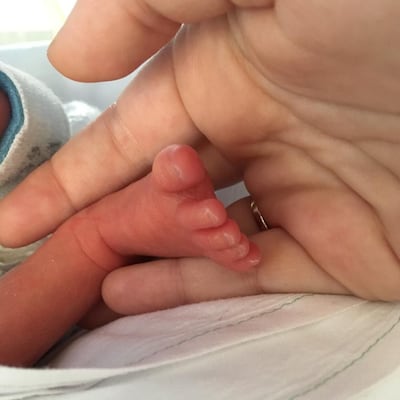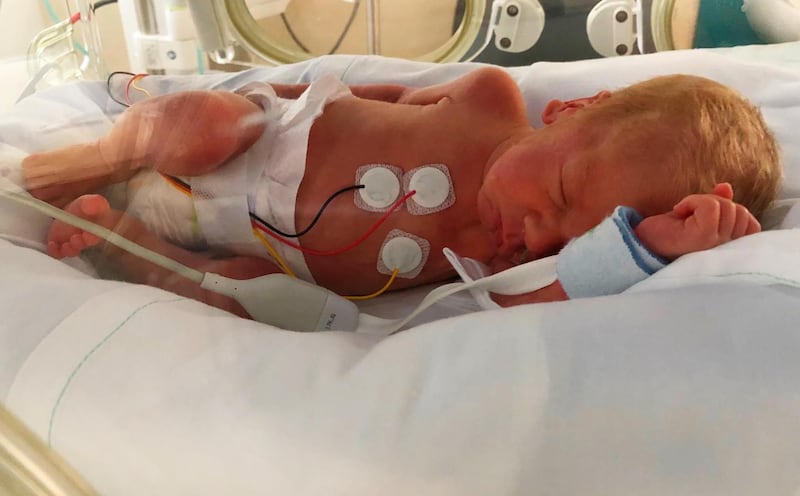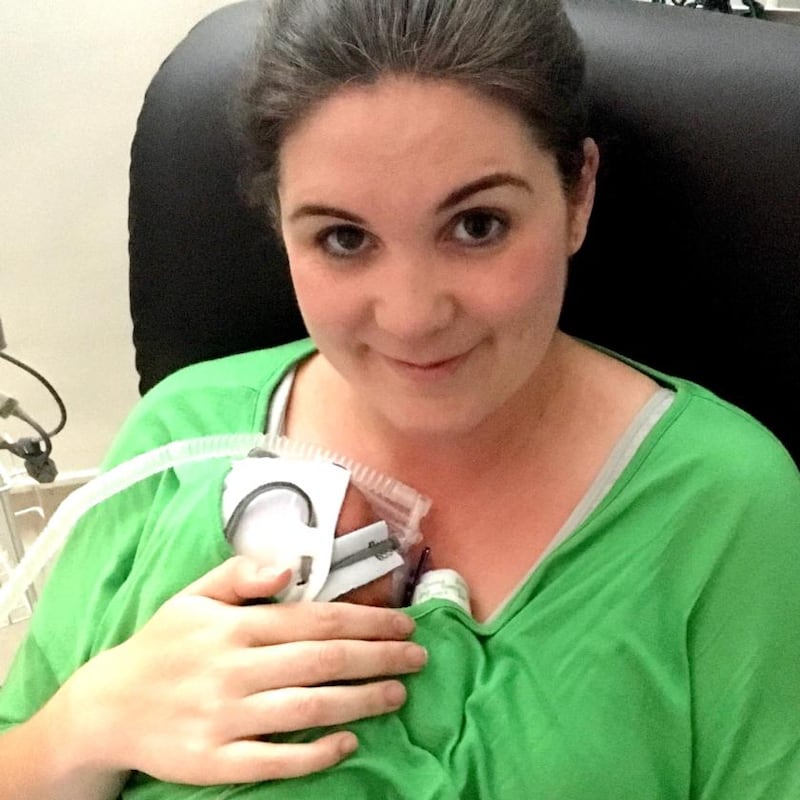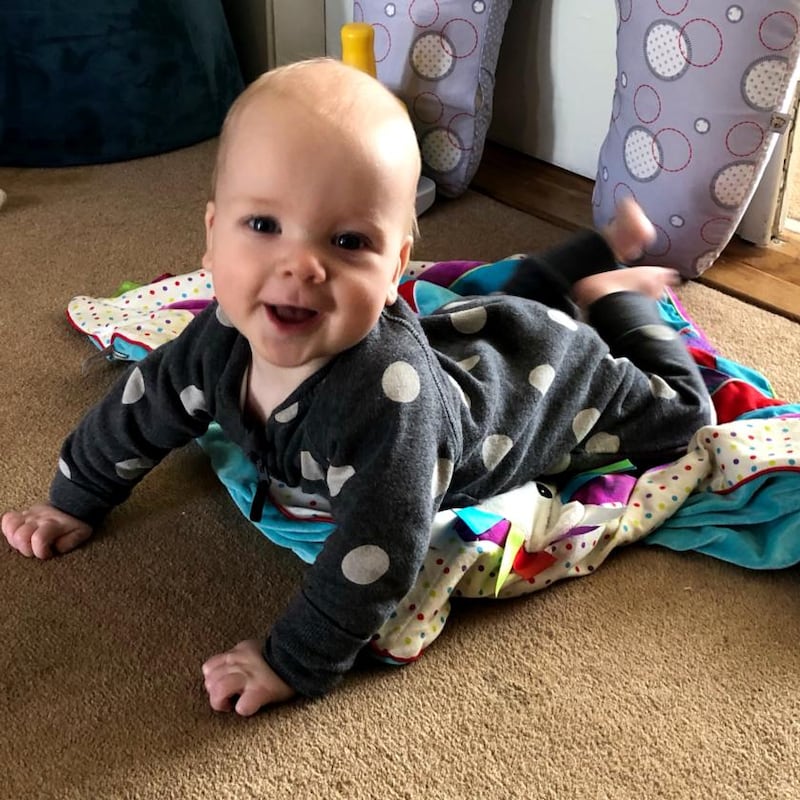On the June bank holiday weekend in 2018, I peered out the window of a stuffy ward in the National Maternity Hospital and listened to the sounds of thousands of jubilant women who had just completed the mini marathon.

The sun was beating down, heralding the start of a long, hot summer, although we didn’t yet know it. The triumphant conversations of dozens of women who had just completed the 10km course reverberated around Holles Street, and bounced off the high hospital walls.
Looking down, I was envious of what those women had achieved, how they had pounded the pavement and come out on the other side with a hard-earned medal.
I was 28 weeks pregnant, and had just been told I had an incompetent cervix. So incompetent it had decided to take a leave of absence
I was 28 weeks pregnant, and had just been told I had an incompetent cervix. So incompetent in fact, it had decided to take a leave of absence. Just a couple of millimetres remained to keep my baby inside me, and I was in danger of going into premature labour at any moment.
This was a much longed-for pregnancy – coming after nearly four years of trying to conceive, three miscarriages and gruelling IVF treatment. We were lucky to have our four-year-old son, and had decided it was nearly time to stop trying for a second child when the last cycle of treatment was successful.
It was a nervy pregnancy. My body was pumped with incredible amounts of drugs in the first and second trimesters to prevent a fourth miscarriage, but I still had a lot of bleeding and scares. Entering the third trimester, I had just started to hope that the rest of the pregnancy would go smoothly. Unfortunately, my cervix didn’t get the memo.
“I guess I won’t be going to work today,” I faltered, when the doctor examining me told me the amniotic sac was actually bulging out of me, that the strange pressure I had been feeling for some time was not paranoia and my waters could in fact break imminently.
The doctor patted my hand as midwives prepared a steroid injection to help mature my baby boy’s lungs, should he arrive in the coming hours.
“You’re not going anywhere for the foreseeable future,” she said.
And so began an indefinite sojourn in Holles Street during the long, hot days of June. I am an in-patient until I go into labour, which could be days or even weeks. If I’m lucky.
Over the coming days, I meet paediatricians and neonatologists who prepare me for what to expect when the baby arrives. I am told to forget my due date of August 22nd. The baby is almost certainly going to be very premature.
I nod mechanically as I am brought through various scenarios – whether the baby will be able to breathe on his own or will need to be ventilated, whether he might have to be transferred to Temple Street if there are any major complications, how even if my waters break they will try to hold off labour as long as possible to give him the best possible chance.
Every additional day the baby stays inside me is vital for his mental and physical development, they stress.
“Absolutely,” I say repeatedly. And: “You do what you have to do.” It’s only when they’re gone that I dissolve into tears.
My waters haven't broken, but I'm having contractions, and the baby is now planning on entering the world left foot first. Emergency C-section it is
Our home life is heavily disrupted by my absence. My husband takes time off work to keep our son’s routine on an even keel, and enlists family and babysitters in the evenings so he can visit me. My son isn’t allowed into the ward, so I can only snatch 10-minute cuddles with him twice a week when I gingerly walk down to the hospital coffee shop. I miss him horribly.
Two weeks slowly go by. The sun continues to glare relentlessly into the ward. I slip into daily routines and come to know what dinner to expect, depending on what day of the week it is. I buy a ridiculous amount of maternity pyjamas online.
A couple of doctors are in favour of letting me go home to continue bedrest there. I am fitted with a surgical coil to support what is left of my cervix. Now there is tentative talk that maybe – just maybe – making my due date isn’t an impossibility after all.
And then I am in labour.
“I don’t feel quite right,” I say to the nurse doing the 6.30am checks, and within minutes I am attached to two drips and several monitors. I am 30 weeks and two days pregnant.

My waters haven’t broken, but I’m having contractions. To complicate matters, the baby is now a footling, planning on entering the world left foot first, the other tucked up neatly out of the way.
Emergency C-section it is.
And then he is here. Did he cry? He must have done. I can’t remember. “Oh he’s so fair!” The consultant exclaims. The briefest of glimpses of a tiny blond head as she lifts him over the parapet to show me, and then he is snatched away to the team of waiting paediatricians.
I had been prepped on the drill. He would immediately be placed in a plastic bag to maintain his body temperature while being assessed. I had imagined it as some kind of foil wrap they put around marathon runners. But no, it’s a sandwich bag like the ones I buy in Tesco for playschool lunches. It has a use-by date section. He fits in it perfectly.
As soon as possible, he is placed in an incubator with a terrifying number of wires and machines attached to it. As he is wheeled out, the staff pause beside me lying on the theatre bed being sewn up, so I can get one more glimpse of my baby before he is whisked off to intensive care.
It will be 14 hours before I can see him, over a day before I can hold him.
To us he is minuscule: a perfectly formed but tiny doll, with a mop of blond hair and a head so small it fits entirely in the palm of my hand. He lies on his tummy in the tiniest nappy I’ve ever seen, wires attached all over his little body. A mask squashes his small face but it helps him to breathe. We name him Theo.

My husband is allowed to see him within a couple of hours, after a chest X-ray. He leans over the incubator in the darkened newborn intensive care unit room and cries. (He will be affectionately known as “the crying daddy” in that unit for the next five weeks.)
I meet our baby after midnight, when I am finally able to walk unaided. I have spent the intermittent hours hunched in bed, frantically trying to express breastmilk that will be badly needed in the coming days.
Did I cry? I must have done. I can’t remember. Later that night when I try to sleep, I keep jolting upright, gasping for air. I literally can’t breathe. I try to explain to the nurses that something must be wrong, that I’ve never had a panic attack in my life. They are very kind.
To the professionals, Theo is a trooper. His birth weight (4lb 6oz) is excellent for a baby of 30 weeks gestation. He will need to stay in intensive care until he is of 35 weeks gestation, until he weighs at least five pounds and until he is able to feed without a tube. But they are confident he will be fine.
We are lucky.
Becoming a newborn intensive care unit parent is like being conscripted into the army. There are rules and regulations, strict schedules to adhere to and procedures to follow
Becoming a newborn intensive care unit parent is like being conscripted into the army. There are rules and regulations, strict schedules to adhere to and procedures to follow. They are essential for the care of the babies, but it is a dizzying adjustment for fraught new parents.
It takes a long time to get in to see your baby, as there are two locked doors and understandably busy staff. You can’t be in there during doctors’ rounds or staff changeovers. I need to pump breastmilk strictly every three hours 24/7 – a procedure that takes half an hour. So I need to be in the hospital pumping room every couple of hours, or else at home. There are often queues outside the pumping rooms.
Countless times I have just got in to see Theo when I need to leave again for doctors’ rounds, or to express milk. Often I just miss feeding time – where we hold up tiny amounts of breastmilk in a bottle and slowly dripfeed it to him through a tube. He can’t be held after feeding, so I sit beside him and feel helpless, singing softly and cupping his head and feet with my hands as taught to reassure him. He sleeps and sleeps.

The best hours each day are the times when I can hold him close to me, under my top, a bonding process known as kangaroo care. His tiny chest flutters against mine, his little head nuzzles into me. I close my eyes and pretend I am pregnant again, that I managed to keep him safe inside me after all.
We bond with other parents who have also been parachuted into this strange world. Some are only there for a few days, others have been there for weeks. We meet women who went into premature labour in Donegal or Longford and who now find themselves far from their young families, staying with relatives or in shared accommodation provided by the hospital. We meet parents who have been told their baby will not be coming home.
We are lucky.
And then it is here, the day we get to bring him home. He is 32 days old, still five weeks off his due date. His little legs don’t fit around the buckle of the car seat. I am more terrified than I ever was bringing my first baby home, and immediately attach a little alarm to his nappy that alerts us if he stops breathing. (I won’t take it off for the next six months.)

But as the experts predicted, our little preemie thrives. The weeks and months go by and soon he is on a par with all his little pals in baby group. I stop telling strangers in the street that he was 10 weeks premature. He smiles. And then he laughs. He crawls and then he pulls himself up. He tries to help himself to his big brother’s Lego.
I complain about sleep deprivation and feel guilty. Then I realise that everything is as it should be.
On the June bank holiday this year, I join those groups of thousands of women and I run the mini marathon. I do it for Theo and to raise funds for Holles Street newborn intensive care unit and the amazing work they do there. I raise more than €1,300 and get my medal. It feels great.
Soon Theo will be one. Doctors have counselled us on steps we can take to avoid another premature birth, and there is a letter coming down the track from the IVF clinic wondering what we would like to do with our remaining embryos. But we know how fortunate we are. We won’t be tempting fate.
Our marathon is complete.











